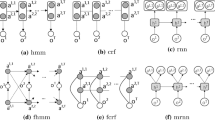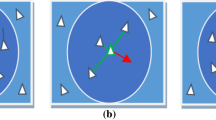Abstract
In recent years, the concept of smart homes and smart buildings have gradually emerged as mainstream with the development of sensor technology and the introduction of several commercial solutions. As one of the most important aspect of this technical-driven smart home system, learning and recognizing the occupant’s routine activities and movement patterns is the foundation of further human behavior understanding and prediction process. In this paper, we propose a decomposition based unsupervised learning approach, which is able to learn the occupant’s moving patterns directly from the sensor data without event annotations. It overcomes the limitation suffered by a lot of other supervised learning approaches that sensor data sets with event annotations are not difficult to collect since manually data labeling is not scalable and extremely time consuming. By applying the proposed method on Aruba motion sensor data set, we show that the decomposition based pattern learning method leverages the well-developed Non-negative Matrix Factorization algorithm that it can learn the movement pattern candidates of the occupant very fast, with outputs that can be easily interpreted.










Similar content being viewed by others
References
Amiribesheli M, Benmansour A, Bouchachia A (2015) A review of smart homes in healthcare. J Ambient Intell Humanized Comput 6(4):495–517
Botia JA, Villa A, Palma J (2012) Ambient assisted living system for in-home monitoring of healthy independent elders. Expert Syst Appl 39(9):8136–8148
Brun L, Saggese A, Vento M (2014) Dynamic scene understanding for behavior analysis based on string kernels. IEEE Trans Circuits Syst Video Technol 24(10):1669–1681
Chen L, Nugent CD, Wang H (2012) A knowledge-driven approach to activity recognition in smart homes. IEEE Trans Knowl Data Eng 24(6):961–974
Chernbumroong S, Cang S, Atkins A, Yu H (2013) Elderly activities recognition and classification for applications in assisted living. Expert Syst Appl 40(5):1662–1674
Cook DJ (2010) Learning setting-generalized activity models for smart spaces. IEEE Intell Syst 2010(99):1
Cook DJ, Krishnan N (2014) Mining the home environment. J Intell Inform Syst 43(3):503–519
Ding D, Cooper RA, Pasquina PF, Fici-Pasquina L (2011) Sensor technology for smart homes. Maturitas 69(2):131–136
Helal S, Mann W, El-Zabadani H, King J, Kaddoura Y, Jansen E (2005) The gator tech smart house: a programmable pervasive space. Computer 38(3):50–60
Ilyas M, Alwakeel SS, Alwakeel MM et al (2014) Sensor networks for sustainable development. CRC Press, New York
Jakkula V, Cook DJ (2008) Anomaly detection using temporal data mining in a smart home environment. Methods Inf Med 47(1):70–75
Kientz JA, Patel SN, Jones B, Price E, Mynatt ED, Abowd GD (2008) The georgia tech aware home. In: CHI’08 extended abstracts on human factors in computing systems. ACM, pp 3675–3680
Krishnan NC, Cook DJ (2014) Activity recognition on streaming sensor data. Pervasive Mob Comput 10:138–154
Lee DD, Seung HS (2001) Algorithms for non-negative matrix factorization. In: Advances in neural information processing systems, pp 556–562
Lee S, Ha KN, Lee KC (2006) A pyroelectric infrared sensor-based indoor location-aware system for the smart home. IEEE Trans Consum Electron 52(4):1311–1317
Morris BT, Trivedi MM (2011) Trajectory learning for activity understanding: unsupervised, multilevel, and long-term adaptive approach. IEEE Trans Pattern Anal Mach Intell 33(11):2287–2301
Ordóñez FJ, Iglesias JA, De Toledo P, Ledezma A, Sanchis A (2013) Online activity recognition using evolving classifiers. Expert Syst Appl 40(4):1248–1255
Rantz MJ, Skubic M, Koopman RJ, Phillips L, Alexander GL, Miller SJ, Guevara RD (2011) Using sensor networks to detect urinary tract infections in older adults. In: E-health networking applications and services (Healthcom), 2011 13th IEEE international conference on, IEEE, pp 142–149
Rashidi P, Cook DJ, Holder LB, Schmitter-Edgecombe M (2011) Discovering activities to recognize and track in a smart environment. IEEE Trans Knowl Data Eng 23(4):527–539
Resendes S, Carreira P, Santos AC (2014) Conflict detection and resolution in home and building automation systems: a literature review. J Ambient Intell Humanized Comput 5(5):699–715
Rho S, Min G, Chen W (2012) Advanced issues in artificial intelligence and pattern recognition for intelligent surveillance system in smart home environment. Eng Appl Artif Intell 25(7):1299–1300
Suryadevara N, Mukhopadhyay SC, Wang R, Rayudu R (2013) Forecasting the behavior of an elderly using wireless sensors data in a smart home. Eng Appl Artif Intell 26(10):2641–2652
van Kasteren T, Englebienne G, Kröse BJ (2010) Activity recognition using semi-markov models on real world smart home datasets. J Ambient Intell Smart Environ 2(3):311–325
Wong KBY, Zhang T, Aghajan H (2014a) Data fusion with a dense sensor network for anomaly detection in smart homes. In: Human behavior understanding in networked sensing. Springer, New York, pp 211–237
Wong KBY, Zhang T, Aghajan H (2014b) Extracting patterns of behavior from a network of binary sensors. J Ambient Intell Humanized Comput 6(1):83–105
Zhang T, Wong KBY, Aghajan H (2014) Concurrent activation events based trajectory propagation in smart environments. J Ambient Intell Humanized Comput 5(6):867–880
Zhang Y, Zhang G, Wang J, Sun S, Si S, Yang T (2015) Real-time information capturing and integration framework of the internet of manufacturing things. Int J Comput Integr Manuf 28(8):811–822
Author information
Authors and Affiliations
Corresponding author
Rights and permissions
About this article
Cite this article
Zhang, T., Fu, W., Ye, J. et al. Learning movement patterns of the occupant in smart home environments: an unsupervised learning approach. J Ambient Intell Human Comput 8, 133–146 (2017). https://doi.org/10.1007/s12652-016-0367-2
Received:
Accepted:
Published:
Issue Date:
DOI: https://doi.org/10.1007/s12652-016-0367-2




